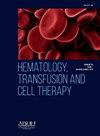Post-thaw dimethyl sulfoxide reduction in autologous peripheral blood progenitor cell suspensions
IF 1.6
Q3 HEMATOLOGY
引用次数: 0
Abstract
Background and objectives
Dimethyl sulfoxide has become the most common cryoprotectant used for cryopreservation of hematopoietic progenitor cells because of its efficiency, regardless of its potentially toxic side effects. Its application is considered safe, provided that the daily dose administered does not exceed 1 gram per kilogram of patient weight. Indications for its reduction after thawing are limited to patients with high risk of malignant arrhythmia and those with severely impaired renal function. However, dimethyl sulfoxide reduction can lead to the loss of viable progenitors.
Methods
A retrospective study of viable hematopoietic progenitor cell recovery after dimethyl sulfoxide reduction was performed with 13 patients (nine men, four women) with secondary amyloidosis in multiple myeloma (n = 9), primary amyloid light chain amyloidosis (n = 3), or severe adverse reaction at the beginning of the hematopoietic progenitor cell concentrate infusion (n = 1). The Wilcoxon signed-rank test was used.
Results
The results of the dimethyl sulfoxide reduction process showed a high recovery of viable nucleated cells (median: 120.85 %), and of viable mononuclear cells (median: 104.53 %). There was a significant decrease in total number of viable CD34+ cells in comparison with data obtained after original collection (median: 51.49 %). No significant decrease in colony-forming unit capacity was observed after dimethyl sulfoxide reduction (median: 93.37 %).
Conclusion
The dimethyl sulfoxide removal process and total process recoveries revealed considerable individual variability. To minimize the risk of prolonged engraftment or non-engraftment, it is important to apply this process only to high-risk patients.
解冻后自体外周血祖细胞悬浮液中二甲亚砜的还原
背景与目的二甲亚砜虽然具有潜在的毒副作用,但由于其高效,已成为最常用的用于造血祖细胞冷冻保存的冷冻保护剂。其应用被认为是安全的,只要每日给药剂量不超过每公斤患者体重1克。解冻后复位的适应症仅限于恶性心律失常的高危患者和肾功能严重受损的患者。然而,二甲亚砜还原可导致活祖细胞的丧失。方法回顾性研究13例(男9例,女4例)多发性骨髓瘤继发性淀粉样变性(n = 9)、原发性淀粉样轻链淀粉样变性(n = 3)或造血祖细胞浓缩输注开始时出现严重不良反应(n = 1)的患者在二甲亚砜还原后存活的造血祖细胞恢复情况。采用Wilcoxon符号秩检验。结果二甲基亚砜还原法对有核细胞和单核细胞的回收率均较高,分别为120.85%和104.53%。与原始收集的数据相比,活CD34+细胞总数显著减少(中位数:51.49%)。减少二甲亚砜后,未观察到菌落形成单位容量显著下降(中位数:93.37%)。结论二甲基亚砜的去除工艺和总工艺回收率存在较大的个体差异。为了尽量减少长时间植入或不植入的风险,重要的是仅对高危患者应用此过程。
本文章由计算机程序翻译,如有差异,请以英文原文为准。
求助全文
约1分钟内获得全文
求助全文
来源期刊

Hematology, Transfusion and Cell Therapy
Multiple-
CiteScore
2.40
自引率
4.80%
发文量
1419
审稿时长
30 weeks
 求助内容:
求助内容: 应助结果提醒方式:
应助结果提醒方式:


